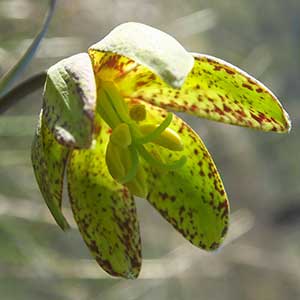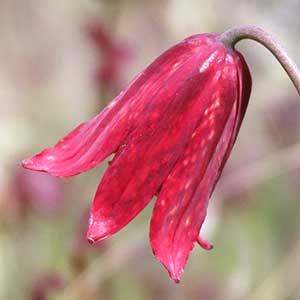Fritillaria glauca
Fritillaria gentneri
Siskiyou fritillary
Gentner's fritillary
5–20 cm.
10–70 cm.
1–4(6), alternate, 3–11 cm long;
blades lance-ovate, sickleshaped, strongly glaucous.
in 1–3 whorls of 3–5 leaves per node or alternate, 5–15 cm long;
blades broadly linear to oblanceolate.
cupshaped;
perianth segments oblanceolate to oblong, 1.5–2(2.5) cm long, yellow with purple mottling to purple with yellow mottling;
apex not recurved;
nectaries broad-lanceolate, 25-33% perianth segment length;
style branched for 50% its length.
perianth segments oblong to oblanceolate, 3–4 cm long, red to purple with yellow mottling;
apex weakly recurved or not;
nectaries linear, approximately 50% perianth segment length;
style branched for 33–50% its length.
capsules winged.
capsules winged.
=24.
=36.
Fritillaria glauca
Fritillaria gentneri
Serpentine and non-serpentine gravelly slopes. Flowering Mar–Jun. 400–2100m. Casc, Sisk. CA. Native.
Fritillaria glauca is our only species that grows in serpentine soils. This species also grows in non-serpentine habitats. This begs the question: Was F. glauca historically a serpentine or non-serpentine endemic? The sickle-shaped and strongly glaucous leaves of F. glauca are distinct among Oregon fritillaries.
Dry woodlands. Flowering Apr–May. 100–1600 m. Sisk. Native.
In addition to morphological traits, DNA evidence implies that F. gentneri is a hybrid between F. affinis and F. recurva (Meyers 2006). Whether this proposed hybridization event was recent or older warrants more study.
Stephen Meyers
Stephen Meyers





